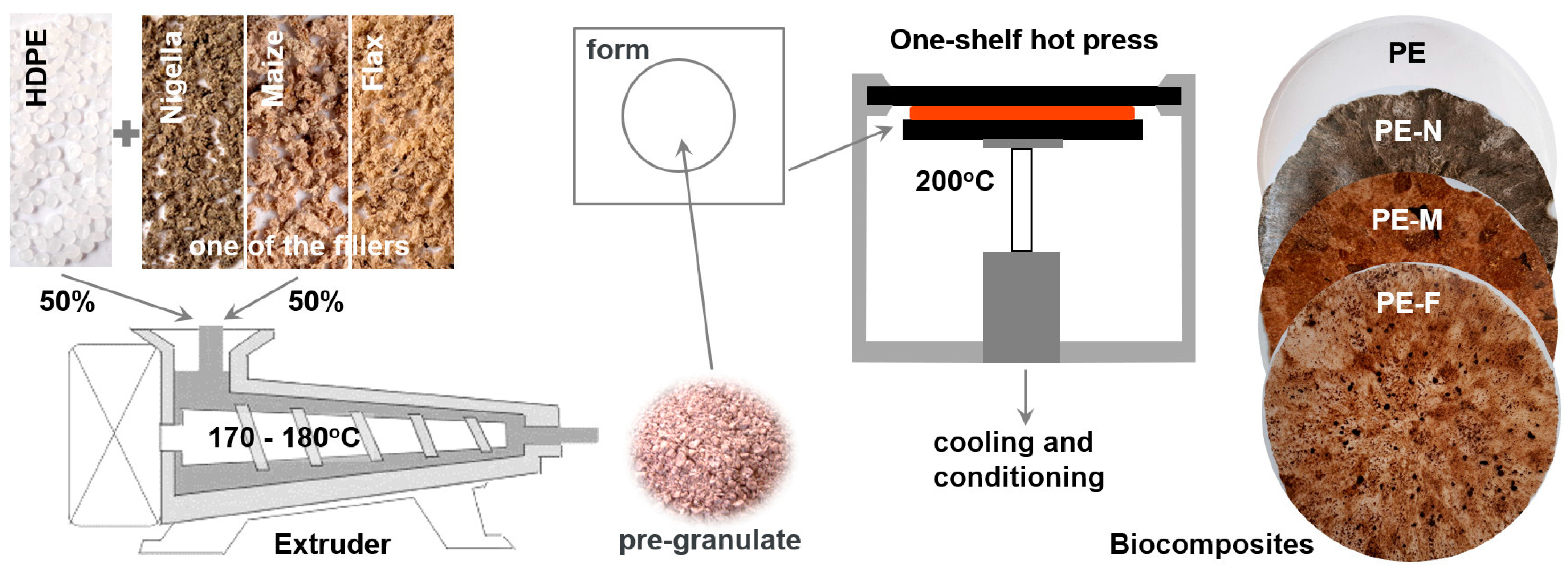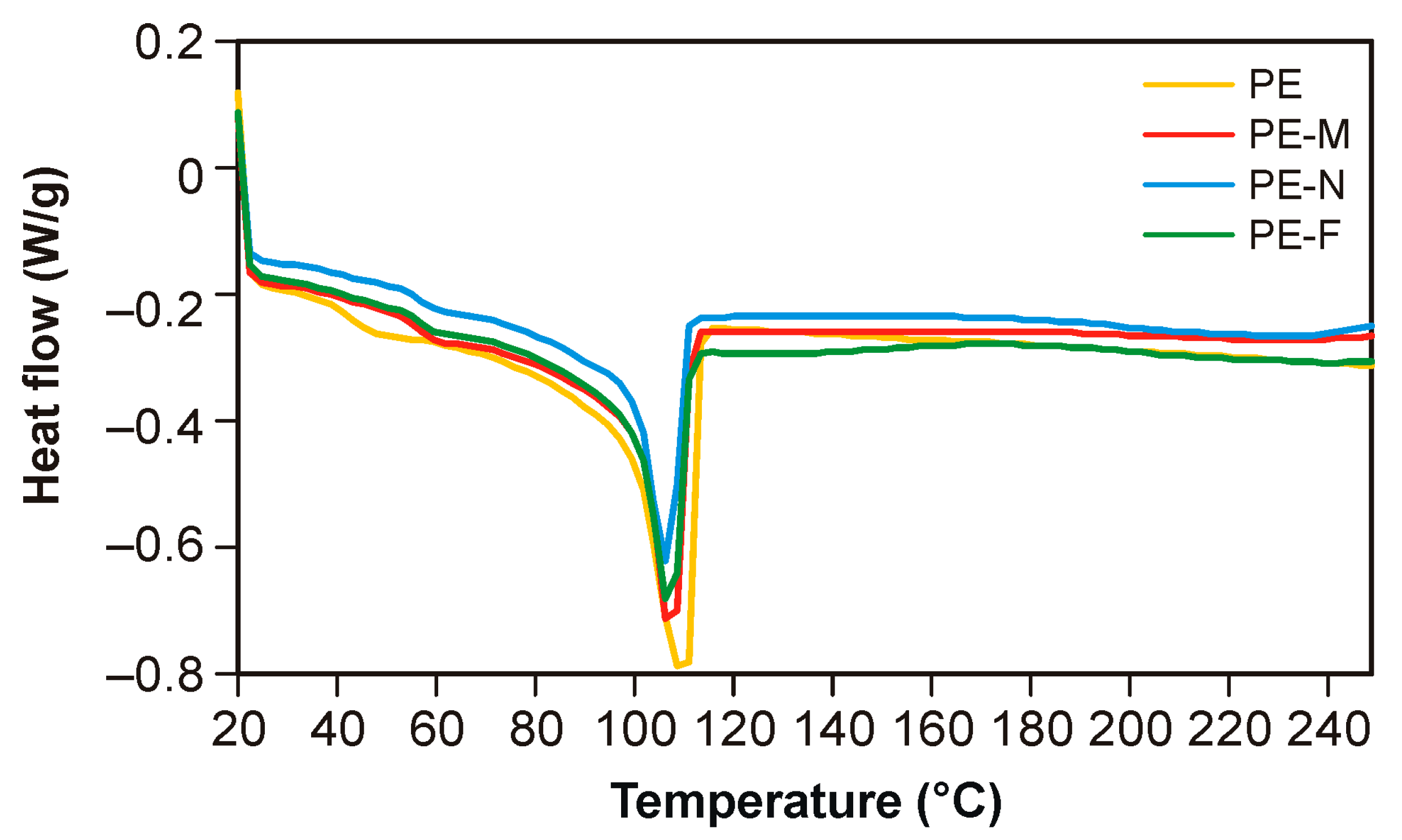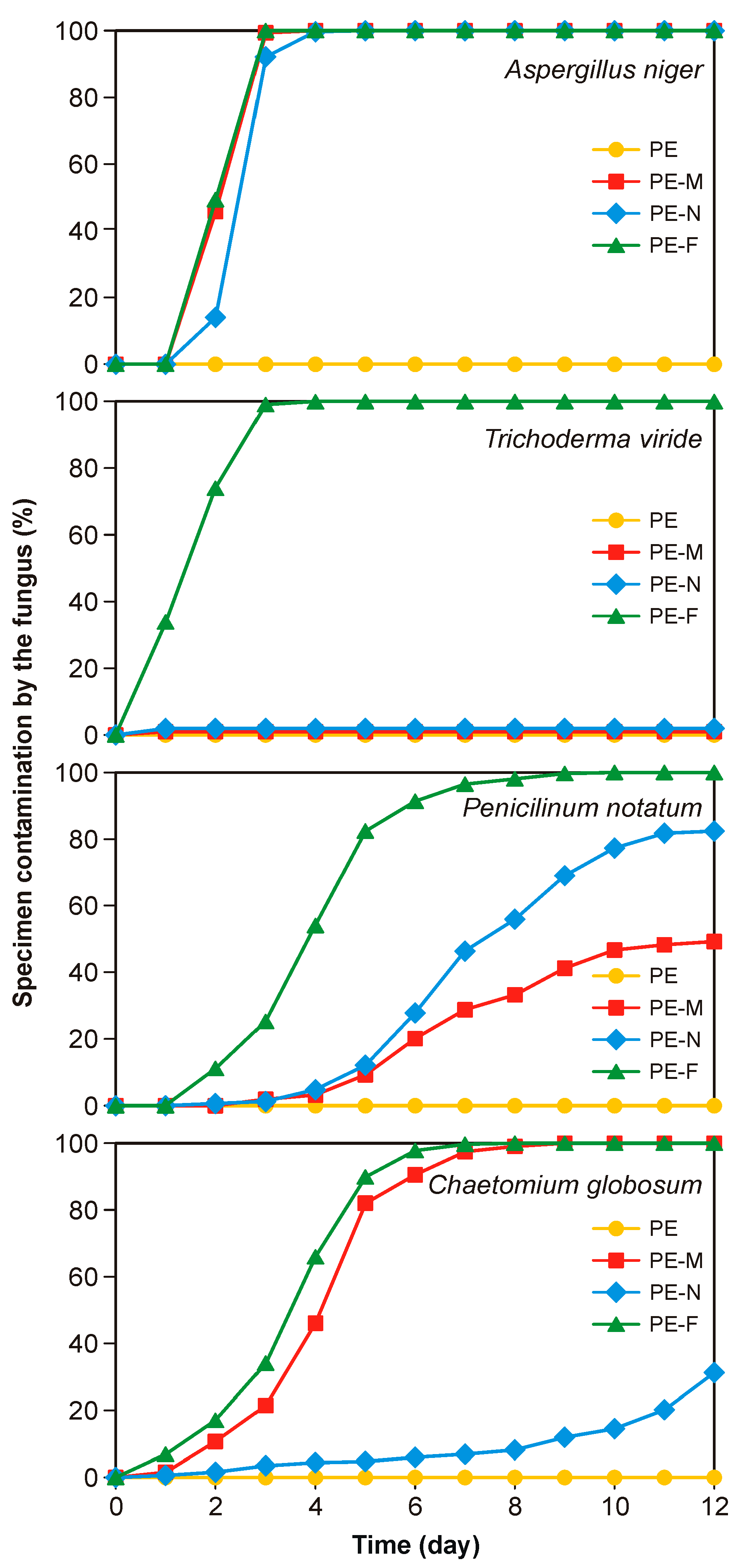Pomace from Oil Plants as a New Type of Raw Material for the Production of Environmentally Friendly Biocomposites
Abstract
:1. Introduction
2. Materials and Methods
2.1. Preparation of Biocomposites
2.2. Characterization of Quality Parameters
2.2.1. X-ray Diffraction Analysis (XRD)
2.2.2. Thermal Properties of Film
2.2.3. Fourier-Transform Infrared Spectroscopy (FTIR)
2.2.4. SEM Analysis
2.2.5. Growth of Fungi
2.2.6. Antioxidant Properties
2.3. Test Standards
3. Results and Discussion
4. Conclusions
Author Contributions
Funding
Institutional Review Board Statement
Informed Consent Statement
Data Availability Statement
Acknowledgments
Conflicts of Interest
References
- Food and Agriculture Organization of United Nations (FAO). The Future of Food and Agriculture—Trends and Challenges; FAO: Rome, Italy, 2017; ISBN 978-92-5-109551-5. Available online: https://www.fao.org/3/i6583e/i6583e.pdf (accessed on 25 August 2023).
- Babu, S.; Singh Rathore, S.; Singh, R.; Kumar, S.; Singh, V.K.; Yadav, S.K.; Yadav, V.; Raj, R.; Yadav, D.; Shekhawat, K.; et al. Exploring Agricultural Waste Biomass for Energy, Food and Feed Production and Pollution Mitigation: A Review. Bioresour. Technol. 2022, 360, 127566. [Google Scholar] [CrossRef]
- Winans, K.; Kendall, A.; Deng, H. The History and Current Applications of the Circular Economy Concept. Renew. Sustain. Energy Rev. 2017, 68, 825–833. [Google Scholar] [CrossRef]
- Koul, B.; Yakoob, M.; Shah, M.P. Agricultural Waste Management Strategies for Environmental Sustainability. Environ. Res. 2022, 206, 112285. [Google Scholar] [CrossRef] [PubMed]
- Ari, I.; Yikmaz, R.F. Chapter 4—Greening of Industry in a Resource- and Environment-Constrained World. In Handbook of Green Economics; Acar, S., Yeldan, E., Eds.; Academic Press: Cambridge, MA, USA, 2019; pp. 53–68. [Google Scholar] [CrossRef]
- Routray, W.; Orsat, V. Chapter 8—Plant By-Products and Food Industry Waste: A Source of Nutraceuticals and Biopolymers. In Handbook of Food Bioengineering, Food Bioconversion; Grumezescu, A.M., Holban, A.M., Eds.; Academic Press: Cambridge, MA, USA, 2017; pp. 279–315. [Google Scholar] [CrossRef]
- Gupte, A.P.; Basaglia, M.; Casella, S.; Favaro, L. Rice Waste Streams as a Promising Source of Biofuels: Feedstocks, Biotechnologies and Future Perspectives. Renew. Sustain. Energy Rev. 2022, 167, 112673. [Google Scholar] [CrossRef]
- Krasowska, M.; Kowalczyk-Sadowy, M. Evaluation of the possibility of using apple pomace for fertilizing purposes. J. Res. Appl. Agric. Eng. 2018, 63, 89–93. [Google Scholar]
- Galal, T.M.; Ali, E.F.; Eid, E.M.; Al-Yasi, H.M.; Magrashi, A.; Althobaiti, F.; Farahat, E.A. Evaluating the Nutrient Contents and Nutritive Value of Taif’s Rose (Rosa damascena Mill var. trigintipetala) Waste to Be Used as Animal Forage or Soil Organic Fertilizers. Agriculture 2022, 12, 1481. [Google Scholar] [CrossRef]
- Juárez-Alvarado, C.A.; Magniont, C.; Escadeillas, G.; Terán-Torres, B.T.; Rosas-Diaz, F.; Valdez-Tamez, P.L. Sustainable Proposal for Plant-Based Cementitious Composites, Evaluation of Their Mechanical, Durability and Comfort Properties. Sustainability 2022, 14, 14397. [Google Scholar] [CrossRef]
- Shih, Y.-F.; Cai, J.-X.; Kuan, C.-S.; Hsieh, C.-F. Plant Fibers and Wasted Fiber/Epoxy Green Composites. Compos. Part B Eng. 2012, 43, 2817–2821. [Google Scholar] [CrossRef]
- Elgamsy, R.; Allah Abo Elmagd, A.; Elrahman Mokhtar, A.M.; Khalid, I.; Taha, N.; Sadek, S.; Tawfic, M.L.; Attia, T.; Elsabbagh, A. Developing Fire Retardant Composites of Biodegradable Polyethylene Reinforced with Agricultural Wastes. Ain Shams Eng. J. 2022, 13, 101768. [Google Scholar] [CrossRef]
- Ashori, A. 2—Hybrid thermoplastic composites using nonwood plant fibers. Hybrid Polym. Compos. Mater. Prop. Characteris. 2017, 39–56. [Google Scholar] [CrossRef]
- Singh, A.; Gu, Y.; Castellarin, S.D.; Kitts, D.D.; Pratap-Singh, A. Development and Characterization of the Edible Packaging Films Incorporated with Blueberry Pomace. Foods 2020, 9, 1599. [Google Scholar] [CrossRef] [PubMed]
- Ballinas-Casarrubias, L.; Camacho-Davila, A.; Gutierrez Méndez, N.; Ramos-Sánchez, V.H.; Chávez-Flores, D.; Manjarrez-Nevárez, L.; Zaragoza-Galán, G.; González-Sanchez, G. Biopolymers from Waste Biomass—Extraction, Modification and Ulterior Uses. In Recent Advances in Biopolymers; InTech: Rijeku, Croatia, 2016. [Google Scholar] [CrossRef]
- Asim, M.; Saba, N.; Jawaid, M.; Nasir, M. 12—Potential of Natural Fiber/Biomass Filler-Reinforced Polymer Composites in Aerospace Applications. In Woodhead Publishing Series in Composites Science and Engineering; Jawaid, M., Thariq, M., Eds.; Woodhead Publishing Series in Composites Science and Engineering: Duxford, UK, 2018; pp. 253–268. [Google Scholar] [CrossRef]
- Arrakhiz, F.Z.; El Achaby, M.; Malha, M.; Bensalah, M.O.; Fassi-Fehri, O.; Bouhfid, R.; Benmoussa, K.; Qaiss, A. Mechanical and Thermal Properties of Natural Fibers Reinforced Polymer Composites: Doum/Low Density Polyethylene. Mater. Des. 2013, 43, 200–205. [Google Scholar] [CrossRef]
- Sullins, T.; Pillay, S.; Komus, A.; Ning, H. Hemp Fiber Reinforced Polypropylene Composites: The Effects of Material Treatments. Compos. Part B Eng. 2017, 114, 15–22. [Google Scholar] [CrossRef]
- Barczewski, M.; Aniśko, J.; Hejna, A.; Mysiukiewicz, O.; Kosmela, P.; Sałasińska, K.; Boczkowska, A.; Przybylska-Balcerek, A.; Stuper-Szablewska, K. Ground lemon and stevia leaves as renewable functional fillers with antioxidant activity for high-density polyethylene composites. Clean Technol. Environ. Policy 2023. [Google Scholar] [CrossRef]
- Jayaraman, K.; Bhattacharyya, D. Mechanical performance of woodfibre- waste plastic composite materials. Resour. Conserv. Recycl. 2004, 41, 307–319. [Google Scholar] [CrossRef]
- Fernandes, E.M.; Correlo, V.M.; Mano, J.F.; Reis, R.L. Novel cork polymer composites reinforced with short natural coconut fibres: E_ect of fibre loading and coupling agent addition. Compos. Sci. Technol. 2013, 78, 56–62. [Google Scholar] [CrossRef]
- Aji, I.S.; Zainudin, E.S.; Khalina, A.; Sapuan, S.M.; Khairul, M.D. Studying the e_ect of fiber size and fiber loading on the mechanical properties of hybridized kenaf/ PALF reinforced HDPE composite. J. Reinf. Plast. Compos. 2011, 30, 546553. [Google Scholar] [CrossRef]
- Banat, R.; Al-Rawashdeh, M.; Aljnaid, M. Thermal Properties of Olive Pomace Filled Linear Low Density Polyethylene Bio-Composites. J. Macromol. Sci. Part B 2021, 60, 957–969. [Google Scholar] [CrossRef]
- Gustafsson, J.; Landberg, M.; Bátori, V.; Åkesson, D.; Taherzadeh, M.J.; Zamani, A. Development of Bio-Based Films and 3D Objects from Apple Pomace. Polymers 2019, 11, 289. [Google Scholar] [CrossRef]
- Raschip, I.E.; Fifere, N.; Dinu, M.V. A Comparative Analysis on the Effect of Variety of Grape Pomace Extracts on the Ice-Templated 3D Cryogel Features. Gels 2021, 7, 76. [Google Scholar] [CrossRef]
- Kumar, A.; Weig, A.R.; Agarwal, S. Balancing Degradability and Physical Properties of Amorphous Poly(d,l-lactide) by Making Blends. Macromol. Mater. Eng. 2022, 307, 2100602. [Google Scholar] [CrossRef]
- Mecking, S. Polyethylene-like materials from plant oils. Philos. Trans. R. Soc. A 2020, 378, 20190266. [Google Scholar] [CrossRef] [PubMed]
- Samir, A.; Ashour, F.H.; Hakim, A.A.A.; Bassyouni, M. Recent advances in biodegradable polymers for sustainable applications. NPJ Mater. Degrad. 2022, 6, 68. [Google Scholar] [CrossRef]
- Prochon, M.; Dzeikala, O. Biopolymer Composites as an Alternative to Materials for the Production of Ecological Packaging. Polymers 2021, 13, 592. [Google Scholar] [CrossRef] [PubMed]
- Muthuraj, R.; Lacoste, C.; Lacroix, P.; Bergeret, A. Sustainable thermal insulation biocomposites from rice husk, wheat husk, wood fibers and textile waste fibers: Elaboration and performances evaluation. Ind. Crops Prod. 2019, 135, 238–245. [Google Scholar] [CrossRef]
- Kamran, M.J.; Jayamani, E.; Heng, S.K.; Wong, Y.C.; Rahman, M.R.; Al-Bogami, A.S.; Huda, D.; Bakri, M.K.B.; Rahman, M.M. Characterization and Comparative Study on Chemically Treated Luffa Fiber as Reinforcement for Polylactic Acid Bio-Composites. BioResources 2022, 17, 2576–2597. [Google Scholar] [CrossRef]
- Mirowski, J.; Oliwa, R.; Oleksy, M.; Tomaszewska, J.; Ryszkowska, J.; Budzik, G. Poly(vinyl chloride) Composites with Raspberry Pomace Filler. Polymers 2021, 13, 1079. [Google Scholar] [CrossRef]
- Betlej, I.; Salerno-Kochan, R.; Borysiuk, P.; Boruszewski, P.; Monder, S.; Krajewski, K.; Andres, B.; Krochmal-Marczak, B.; Pisulewska, E.; Danecki, L.; et al. Quality Parameters of PE–Pomace Based Membranes. Membranes 2022, 12, 1086. [Google Scholar] [CrossRef]
- Hindeleh, A.M.; Johnson, D.J. The resolution of multipeak data in fibre science. J. Phys. Appl. Phys. 1971, 4, 259–263. [Google Scholar] [CrossRef]
- Betlej, I.; Krajewski, K.; Borysiuk, P. An assessment of the susceptibility of bacterial cellulose films to fouling by mold fungi. Ann. WULS-SGGW For. Wood Technol. 2020, 110, 103–109. [Google Scholar] [CrossRef]
- Nenadis, N.; Tsimidou, M.Z. DPPH (2,2-di(4-tert-octylphenyl)-1-picrylhydrazyl) radical scavenging mixed-mode colorimetric assay(s). In Measurement of Antioxidant Activity & Capacity: Recent Trends and Applications; Apak, R., Capanoglu, E., Eds.; Wiley: Hoboken, NJ, USA, 2018; pp. 141–161. [Google Scholar] [CrossRef]
- Yijian, L.; Weichuan, D.; Demin, T.; Wei, Z.; Qiangguo, D. Space chargé distribution and crystalline structure in low density polyethylene (LDPE) blended with high density polyethylene (HDPE). Polym. Int. 2005, 54, 465–470. [Google Scholar]
- Liao, C.Z.; Tjong, S.C. Mechanical and thermal performance of high-density polyethylene/alumina nanocomposites. J. Macromol. Sci. B. 2012, 52, 812–825. [Google Scholar] [CrossRef]
- de Souza Coelho, C.C.; Soares Silva, R.B.; Carvalho, C.W.P.; Rossi, A.L.; Teixeira, J.A.; Freitas-Silva, O.; Correa Cabral, L.M. Cellulose nanocrystals from grape pomace and their use for the development of starch-based nanocomposite films. Int. J. Biol. Macromol. 2020, 159, 1048–1061. [Google Scholar] [CrossRef] [PubMed]
- Dintcheva, N.T.; Infurna, G.; Baiamonte, M.; D’Anna, F. Natural Compounds as Sustainable Additives for Biopolymers. Polymers 2020, 12, 732. [Google Scholar] [CrossRef]
- Bajsic, E.G.; Persic, A.; Jemric, T.; Buhin, J.; Kucic Grgic, D.; Zdraveva, E.; Zizek, K.; Holjevac Grguric, T. Preparation and Characterization of Polyethylene Biocomposites Reinforced by Rice Husk: Application as Potential Packaging Material. Chemistry 2021, 3, 1344–1362. [Google Scholar] [CrossRef]
- Cisneros-López, E.O.; Pérez-Fonseca, A.A.; González-García, Y.; Ramírez-Arreola, D.E.; González-Núñez, R.; Rodrigue, D.; Robledo-Ortíz, J.R. Polylactic acid–agave fiber biocomposites produced by rotational molding: A comparative study with compression molding. Adv. Polym. Technol. 2018, 37, 2528–2540. [Google Scholar] [CrossRef]
- Garbarczyk, J.; Borysiak, S. Polypropylene—Cellulose fibres composites. Part I. Influence of conditions of extrusion and injection processes on the structure of polypropylene matrix. Polimery 2004, 49, 541–546. [Google Scholar] [CrossRef]
- Grząbka-Zasadzińska, A.; Klapiszewski, Ł.; Borysiak, S.; Jesionowski, T. Thermal and Mechanical Properties of Silica–Lignin/Polylactide Composites Subjected to Biodegradation. Materials 2018, 11, 2257. [Google Scholar] [CrossRef]
- Smith, B. The infrared spectra of polymers II: Polyethylene. Spectroscopy 2021, 36, 22–25. [Google Scholar] [CrossRef]
- Kovács, R.L.; Csontos, M.; Gyöngyösi, S.; Elek, J.; Parditka, B.; Deák, G.; Kuki, Á.; Kéki, S.; Erdélyi, Z. Surface characterization of plasma-modified low density polyethylene by attenuated total reflectance fourier-transform infrared (ATR-FTIR) spectroscopy combined with chemometrics. Polym. Test. 2021, 96, 107080. [Google Scholar] [CrossRef]
- Rohman, A.; Sudjadi, D.W.; Lukitaningsih, E.; Rosman, A.S. Use of Fourier Transform Infrared Spectroscopy in Combination with Partial Least Square for Authentication of Black Seed Oil. Int. J. Food Prop. 2015, 18, 775–784. [Google Scholar] [CrossRef]
- Mohammed, S.J.; Amin, H.H.; Aziz, S.B.; Sha, A.M.; Hassan, S.; Abdul Aziz, J.M.; Rahman, H.S. Structural characterization, antimicrobial activity, and in vitro cytotoxicity effect of black seed oil. Evid Based Complement. Altern. Med. 2019, 2019, 6515671. [Google Scholar] [CrossRef]
- Alix, S.; Philippe, E.; Bessadok, A.; Lebrun, L.; Morvan, C.; Marais, S. Effect of chemical treatments on water sorption and mechanical properties of flax fibres. Bioresour. Technol. 2009, 100, 4742–4749. [Google Scholar] [CrossRef] [PubMed]
- Geminiani, L.; Campione, F.P.; Corti, C.; Luraschi, M.; Motella, S.; Recchia, S.; Rampazzi, L. Differentiating between Natural and Modified Cellulosic Fibres Using ATR-FTIR Spectroscopy. Heritage 2022, 5, 4114–4139. [Google Scholar] [CrossRef]
- Suárez, L.; Ortega, Z.; Romero, F.; Paz, R.; Marrero, M. Influence of Giant Reed Fibers on Mechanical, Thermal, and Disintegration Behavior of Rotomolded PLA and PE Composites. J. Polym. Environ. 2022, 30, 4848–4862. [Google Scholar] [CrossRef]
- Andrzejewski, J.; Krawczak, A.; Wesoły, K.; Szostak, M. Rotational molding of biocomposites with addition of buckwheat husk filler. Structure-property correlation assessment for materials based on polyethylene (PE) and poly(lactic acid) PLA. Compos. Part B 2020, 202, 108410. [Google Scholar] [CrossRef]
- Korol, J.; Lenża, J.; Formela, K. Manufacture and research of TPS/PE biocomposites properties. Compos. Part B 2015, 68, 310–316. [Google Scholar] [CrossRef]
- Monteiro, S.N.; Calado, V.; Rodriguez, R.J.S.; Margem, F.M. Thermogravimetric behavior of natural fibers reinforced polymer composites—An overview. Mater. Sci. Eng. A 2012, 557, 17–28. [Google Scholar] [CrossRef]
- da Costa Borges, M.A.; Sorigotti, A.R.; Paschoalin, R.T.; Júnior, J.A.P.; da Silva, L.H.D.; Dias, D.S.; Ribeiro, C.A.; de Araújo, E.S.; Resende, F.A.; da Silva Barud, H. Self-Supported Biopolymeric Films Based on Onion Bulb (Allium cepa L.): Gamma-Radiation Effects in Sterilizing Doses. Polymers 2023, 15, 914. [Google Scholar] [CrossRef]
- Abdel-Latif, E.F.; Abbas, K.A.; Abdelmontaleb, H.S.; Hamdy, S.M. Nigella sativa oil: A promising prospective antifungal agent in the manufacture of low-salt soft cheese. Ital. J. Food Saf. 2021, 10, 9862. [Google Scholar] [CrossRef]
- Alix, S.; Marais, S.; Morvan, C.; Lebrun, L. Biocomposite materials from flax plants: Preparation and properties. Compos. Part A Appl. Sci. Manuf. 2008, 39, 1793–1801. [Google Scholar] [CrossRef]
- Canales, D.; Montoille, L.; Rivas, L.M.; Ortiz, J.A.; Yañez-S, M.; Rabagliati, F.M.; Ulloa, M.T.; Alvarez, E.; Zapata, P.A. Fungicides Films of Low-Density Polyethylene (LDPE)/Inclusion Complexes (Carvacrol and Cinnamaldehyde) against Botrytis cinereal. Coatings 2019, 9, 795. [Google Scholar] [CrossRef]
- Al-Maqtari, Q.A.; Ali Mahdi, A.; Al-Ansi, W.; Mohammed, J.K.; Wei, M.; Yao, W. Evaluation of bioactive compounds and antibacterial activity of Pulicaria jaubertii extract obtained by supercritical and conventional methods. J. Food Meas. Charact. 2021, 15, 449–456. [Google Scholar] [CrossRef]
- Ordon, M.; Nawrotek, P.; Stachurska, X.; Mizielińska, M. Polyethylene Films Coated with Antibacterial and Antiviral Layers Based on CO2 Extracts of Raspberry Seeds, of Pomegranate Seeds and of Rosemary. Coatings 2021, 11, 1179. [Google Scholar] [CrossRef]
- Solano, A.C.V.; de Rojas Gante, C. Two different processes to obtain antimicrobial packaging containing natural oils. Food. Bioprocess Technol. 2012, 5, 2522–2528. [Google Scholar] [CrossRef]
- Wang, S.; Marcone, M.F.; Barbut, S.; Lim, L.-T. Fortification of dietary biopolymers-based packaging material with bioactive plant extracts. Food Res. Int. 2012, 49, 80–91. [Google Scholar] [CrossRef]
- Souza, V.G.L.; Rodrigues, P.F.; Duarte, M.P.; Fernando, A.L. Antioxidant Migration Studies in Chitosan Films Incorporated with Plant Extracts. J. Renew. Mater. 2018, 6, 548–558. [Google Scholar]







| Name * | Degree of Crystallinity Xc (%) |
|---|---|
| PE | 52 |
| PE-M | 40 |
| PE-N | 33 |
| PE-F | 42 |
| Name | Tm (°C) | Total Energy Consumption (mJ) | ΔH (J/g) |
|---|---|---|---|
| PE | 109.94 | 472.94 | 122.21 |
| PE-M | 107.36 | 332.75 | 82.77 |
| PE-N | 106.24 | 261.02 | 65.58 |
| PE-F | 106.66 | 234.77 | 65.95 |
| Name | Phase I | Phase II | Phase III | |||
|---|---|---|---|---|---|---|
| Temperature (°C) | Loss of Weight (%) | Temperature (°C) | Loss of Weight (%) | Temperature (°C) | Loss of Weight (%) | |
| PE | - | - | - | - | 465.39 | 98.24 |
| PE-M | - | - | 300.18 | 14.63 | 466.26 | 76.56 |
| PE-N | 207.97 | 14.80 | 301.28 | 39.17 | 467.37 | 20.43 |
| PE-F | - | - | - | - | 466.41 | 84.16 |
| Name | DPPH• Radical Scavenging Activity (µmol Trolox/cm3) |
|---|---|
| PE | 0.02 A |
| PE-M | 0.43 B |
| PE-N | 0.64 C |
| PE-F | 0.51 D |
| Source of Variation | Sum of Squares | Mean Sum of Squares | Fisher’s F-Test | Significance Level | Percentage of Contribution |
|---|---|---|---|---|---|
| SS | MS | F | p | P [%] | |
| type of biocomposite | 52,149.4 | 17,383.1 | 47.6669 | 0.000000 | 48.8 |
| species of fungi | 25,298.2 | 12,649.1 | 34.6856 | 0.000000 | 23.7 |
| type of biocomposite x specie of fungi | 16,707.3 | 2784.6 | 7.6356 | 0.000027 | 15.6 |
| error | 12,763.8 | 364.7 | 11.9 |
| Type of Biocomposites | Specie of Fungi | Degree of Fouling of the Biocomposite Surface by Fungi after 12 Days (%) | Homogeneous Groups in Tukey’s Test with α = 0.05 |
|---|---|---|---|
| PE | Aspergillus niger | 0.14 | A |
| PE | Trichoderma viride | 0.00 | A |
| PE | Penicillium notatum | 0.00 | A |
| PE | Chaetomium globosum | 0.00 | A |
| PE-M | Aspergillus niger | 100.00 | D |
| PE-M | Trichoderma viride | 1.18 | A |
| PE-M | Penicillium notatum | 51.76 | B, C |
| PE-M | Chaetomium globosum | 100.00 | D |
| PE-N | Aspergillus niger | 100.00 | D |
| PE-N | Trichoderma viride | 0.00 | A |
| PE-N | Penicillium notatum | 83.98 | C, D |
| PE-N | Chaetomium globosum | 31.33 | A, B |
| PE-F | Aspergillus niger | 100.00 | D |
| PE-F | Trichoderma viride | 100.00 | D |
| PE-F | Penicillium notatum | 100.00 | D |
| PE-F | Chaetomium globosum | 100.00 | D |
Disclaimer/Publisher’s Note: The statements, opinions and data contained in all publications are solely those of the individual author(s) and contributor(s) and not of MDPI and/or the editor(s). MDPI and/or the editor(s) disclaim responsibility for any injury to people or property resulting from any ideas, methods, instructions or products referred to in the content. |
© 2023 by the authors. Licensee MDPI, Basel, Switzerland. This article is an open access article distributed under the terms and conditions of the Creative Commons Attribution (CC BY) license (https://creativecommons.org/licenses/by/4.0/).
Share and Cite
Betlej, I.; Borysiuk, P.; Borysiak, S.; Rybak, K.; Nowacka, M.; Barlak, M.; Andres, B.; Krajewski, K.; Lipska, K.; Cebulak, T.; et al. Pomace from Oil Plants as a New Type of Raw Material for the Production of Environmentally Friendly Biocomposites. Coatings 2023, 13, 1722. https://doi.org/10.3390/coatings13101722
Betlej I, Borysiuk P, Borysiak S, Rybak K, Nowacka M, Barlak M, Andres B, Krajewski K, Lipska K, Cebulak T, et al. Pomace from Oil Plants as a New Type of Raw Material for the Production of Environmentally Friendly Biocomposites. Coatings. 2023; 13(10):1722. https://doi.org/10.3390/coatings13101722
Chicago/Turabian StyleBetlej, Izabela, Piotr Borysiuk, Sławomir Borysiak, Katarzyna Rybak, Małgorzata Nowacka, Marek Barlak, Bogusław Andres, Krzysztof Krajewski, Karolina Lipska, Tomasz Cebulak, and et al. 2023. "Pomace from Oil Plants as a New Type of Raw Material for the Production of Environmentally Friendly Biocomposites" Coatings 13, no. 10: 1722. https://doi.org/10.3390/coatings13101722






